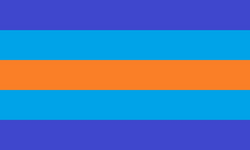Multigender
 | |
| Under the umbrella term | Nonbinary |
|---|---|
| Frequency | 0.7% |
| Click here to see alternative flags! | |
Multigender means having multiple gender identities, either at the same time or moving between different gender identities at different times. It's an umbrella term, but may also be used as a specific gender identity, and multigender identities all fall under the nonbinary and transgender umbrellas. The multigender umbrella includes bigender, trigender, polygender, pangender, genderfluid, and possibly androgyne. They may or may not seek a physical transition to change their body.[1]
In a 2015 survey of non-cis people in the USA, 4% of respondents (about 1,108 people) were multigender.[2]
List of specific kinds of multigender identities[edit | edit source]
Transgender people have created many words for specific kinds of multigender identities. These are some of the most used multigender identities:
- abigender is experiencing two distinct genders, either simultaneously or at different times, but only having a loose or vague connection to each gender while also not feeling like either gender is "neutral" or "neither".
- ambigender is experiencing two genders simultaneously and without fluidity or shifting.[3] This word has also been defined as like being ambidextrous, only with gender. It has also been defined as a synonym for bigender (see below).
- bigender is an identity with two gender identities. This word can mean both genders at the same time, or moving between two genders. In the latter case, bigender is a specific kind of genderfluid identity.
- demiflux is used by polygender or bigender people to describe when one of their genders is static and the other change in intensity and presence.[4]
- genderfluid is a gender identity that changes from one time to the next. For example, a genderfluid person could be both a boy and a girl one day, and then genderless the next.[5]
- pangender is an identity with a wide multiplicity of genders that can tend to the infinite (only includes genders of one's culture. This applies to all other nonbinary genders, because one cannot identify with gender(s) outside their culture).[6]
- polygender is an identity with several gender identities, particularly four or more of them. This can mean at different times, or at the same time.[7]
- trigender is an identity with three gender identities. This word can mean all three at once, or moving between three genders.[8]
See also[edit | edit source]
References[edit | edit source]
- ↑ Nersesyan, Mihran (23 June 2018). "What It Means To Be MultiGender: The Questions Many Have, But Are Afraid To Ask". The Body Is Not An Apology. Archived from the original on 17 July 2023. Retrieved 24 October 2020.
- ↑ "2015 U.S. Transgender Survey Complete Report" (PDF). p. 44. Archived from the original (PDF) on 17 July 2023. Retrieved 23 October 2020.
- ↑ https://en.wiktionary.org/wiki/ambigender Archived on 17 July 2023
- ↑ http://www.thecsph.org/id-a-day-a-demigender/ Archived on 17 July 2023
- ↑ Marsh, Sarah (23 March 2016). "The gender-fluid generation: young people on being male, female or non-binary". the Guardian. Archived from the original on 17 July 2023. Retrieved 24 May 2020.
- ↑ "Pangender". Gender Wiki. 31 August 2018. Archived from the original on 17 July 2023. Retrieved 9 November 2020.
- ↑ https://en.wiktionary.org/wiki/polygender Archived on 17 July 2023
- ↑ https://en.wiktionary.org/wiki/trigender Archived on 17 July 2023
